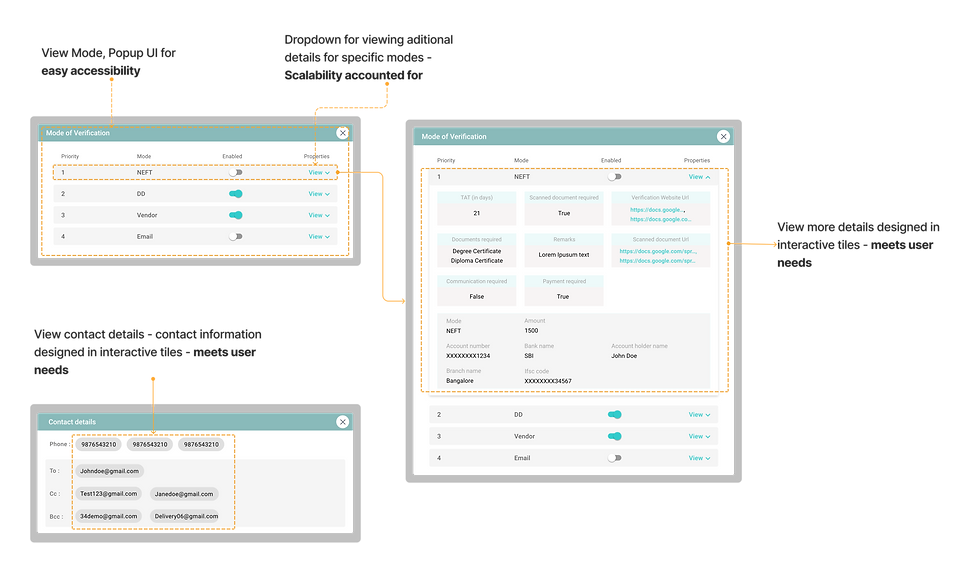To comply with my non-disclosure agreement, I have changed some of the quantitative data and omitted some information in this case study.
Impact
-
Reduction in average EDV turnaround time
-
Increase in user productivity volume
-
Reduction in user errors related to data entry
My Role
-
User Research
-
User Behaviour Analysis
-
User Journey Mapping
-
Rapid Prototyping
-
Interaction Design
My Team
-
Myself - Sole UI & UX Designer
-
1 - Product Manager
-
3 Engineers - 2 Back End & 1 Front End
Introduction
Overview
An information repository is a centralized storage system where data is aggregated, organized, and maintained for easy access. It serves as a place where users can retrieve data as needed. The repository may also offer features that allow users to selectively extract or query specific pieces of data, enhancing usability and efficiency.
Problem
The company's operation team uses ODIN, an in-house application software to manage and conduct the required verifications services. Whereas for EDV (Education Verification) the operations team use google spreadsheets in its asset pipeline as their repository. Information and other data are extracted from these spreadsheets shared among internal teams and external contractors.
Here the problems are:
-
The Repository (google spreadsheets) is detached from the in-house application software.
-
slow turnaround time due to juggling between applications
-
Decreased user productivity due to manual work
-
Limited filtration options.
-
Manual process, more chance of user errors


Solution
Having a custom made builtin repository designed within the in-house software making it more accessible to the Ops team. Creating a Repository system within ODIN (Internal tool).
-
Increased user productivity
-
User friendly experience within Interface
-
Decreased user errors
-
Faster TAT (turnaround time)
-
Decreased training costs
-
Savings gained from making changes earlier in the design life cycle

Repository Prototype
The repository is designed to help users easily switch between institutes and vendors without confusion. It allows users to add important details to each institute, like setting priorities, so they can focus on what needs attention first. This makes the whole process smoother, faster, and easier to manage.

Research
The users
The users are the trained operational analysts of OnGrid who will use the information repository to complete their verification tasks. Though the users are trained professionals, the objective is to create a user friendly interface that would make the user perform, navigate with ease.
Analysing the current process
In order to understand the current process of Education Verification, I conducted interviews with the relative operation team members and did user testing of the existing flow with 3 different colleagues.
I created a user journey map to help visualise the path of the user which allowed me to identify the pain points in their task journey.


Design
Defining the Requirements
In order to create an enhanced repository experience for all EDV repository users, it was crucial to establish a solid foundation. This involved a thorough study of the existing repository structure and information organization at various levels. Collaboratively, the Product Manager and I developed a comprehensive Product Requirements Document (PRD). This document detailed the necessary features, functionalities, and expected behavior of the new repository, serving as a blueprint for the design and development process.
Institute Management

Prioritizing Verification Methods for Faster Turnaround
"One of the key improvements in the Education Verification Repository was the introduction of additional properties beyond basic institute details — specifically, the ability to define multiple modes of verification and assign priority levels to each. This design decision enabled users to view and act on the most efficient verification method available, significantly reducing turnaround time (TAT) and improving overall task flow.
Add New Institute

Mode of Verification
View Details

Designing Efficient Interaction Flows
The repository interaction flow is designed to organize and streamline navigation and CRUD operations, improving overall task efficiency. This was achieved by applying UX heuristics, structuring and organizing data effectively, and continuously testing and iterating throughout the design process to ensure usability and scalability.

Simplifying the Complex
The Repository represented effective data visualization, clear visual hierarchy, and interaction design rooted in user behavior to help users navigate their tasks. Each design decision aimed to surface meaningful insights while avoiding information overload. The Repository is a scalable, user-friendly interface that simplifies decision-making and supports efficient task execution.
What’s Next
Looking ahead, aim to further accelerate Education Verification (EDV) and enhance customer experience through strategic automation and efficiency improvements. This includes exploring direct API integrations, workflow automation, real-time updates, and mobile accessibility. By optimizing processes and minimizing manual effort, strive for quicker Turnaround Times, reduced operational overhead, and a more seamless, transparent experience for our customers.

